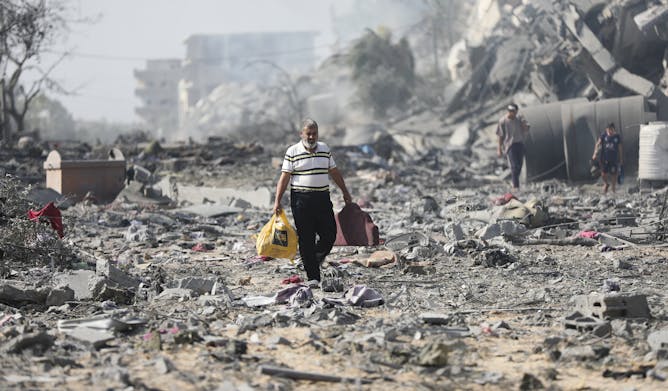|
|
|
|
Top headlines
Lead story
The first humanitarian aid convoy since the start of the Israel-Gaza war arrived in the densely populated territory of Gaza on Saturday.
Gaza’s more than 2 million inhabitants will need many more shipments of food, water and medicine for the foreseeable future due to what Israeli officials have called a “full siege.” Aid donors and United Nations personnel on the ground will have to keep thinking through the complex factors that arise whenever the people in power have a track record of brutality – as is the case with Hamas in Gaza.
Aid workers and officials need to decide “to what extent they can work with governments and local authorities that commit violent acts,” writes Topher L. McDougal, a scholar of peace and conflict economics. This cooperation happens “in exchange for the access required to help civilians under their control.”
One last note: This weekend, The Conversation U.S. celebrated our ninth birthday. During that time, we’ve published almost 19,000 articles by over 13,000 experts that have been read well over a billion times. Thank you to our authors, donors, university members, staff – and especially to you, our readers. 🎉
|

|
Emily Schwartz Greco
Philanthropy + Nonprofits Editor
|
|

Palestinians on the outskirts of Gaza City walk by buildings destroyed by Israeli bombardment on Oct. 20, 2023.
AP Photo/Ali Mahmoud
Topher L. McDougal, University of San Diego
The politics of delivering aid in war zones are messy, the ethics fraught and the logistics daunting. But getting everything right is essential − and in this instance could save many Gazans’ lives.
|
Politics + Society
|
-
Asher Kaufman, University of Notre Dame
Hezbollah dominates Lebanon’s sectarian political system, giving the paralyzed government little choice if the militant group chooses to join Hamas’ war against Israel.
-
Cynthia Alkon, Texas A&M University
With co-defendants of Donald Trump accepting plea bargains, an expert in criminal law explains what these legal agreements are and how they work.
|
|
Science + Technology
|
-
Elizabeth Swanner, Iowa State University
An unusual lake with distinct layers of low-oxygen and high-iron water lets researchers investigate conditions like those in the early Earth’s oceans.
-
Ari Berkowitz, University of Oklahoma
Spanning evolutionary biology, genetics, development, neurobiology, endocrinology and psychology, as well as current events and sports, students explore the complexities of the biology of sex.
-
David Rosenberg, Wayne State University; Natalia Szura, Wayne State University
Up to 50% of US teens feel they are addicted to their devices. But help is out there.
|
|
Arts + Culture
|
-
Shannon Toll, University of Dayton
Despite the perpetrators being tried and convicted, anti-Indigenous sentiment roiled the area for decades.
|
|
Ethics + Religion
|
-
Rebecca T. Alpert, Temple University
Ruth’s headline-grabbing home runs helped his sport recover from scandal, while his own story helped combat anti-Catholic prejudice.
|
|
|
|
Author Comments 💬 |
|---|
“I completely agree with “use it or lose it.” This also goes for the body’s anabolic capabilities where we need to consistently stress the body to maximize return on investment and build up the body after working out. As you age, anabolic ability naturally declines, but similar to muscle strength and size, this can be combatted and the decrease slowed down with proper exercise.”
– Zachary Gillen on the story Steep physical decline with age is not inevitable – here’s how strength training can change the trajectory -
More of The ConversationLike this newsletter? You might be interested in our weekly and biweekly emails: Trying out new social media? Follow us: -
About The ConversationWe're a nonprofit news organization dedicated to helping academic experts share ideas with the public. We can give away our articles thanks to the help of foundations, universities and readers like you.
|
|
| |
| |
| |
| |
|
|
|
|
|
|
|